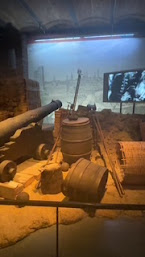Independence: Visiting the Catalan National Assembly
I visited the Catalan National Assembly (ANC) for a presentation on Catalonia's independence movement, and I walked away with a new understanding of how urban space, memory, and identity are tied to politics. The speaker covered a lot of the trauma of the Franco era to the present-day challenges of organizing referendums in Catalonia. What stood out the most was how landscape and law have shaped Catalonia's political path, especially in contrast with the Basque Country.
When I asked a question about whether the Basque independence movement was similar, the answer was that organizing mass protests and political action is harder in Catalonia than in the Basque region, but this is due to urban accessibility. The Basque Country is mountainous and decentralized, making hiding, organizing, and avoiding government suppression easier. By Contrast, Catalonia's flat terrain and dense urban layout- especially around Barcelona make it easier for the Spanish government to control and regulate demonstrations. This links to my research, where I study how land use can affect the demographics, even giving others more power, surveillance, and resistance. I see this in the source, "Urban Planning Paradoxes and Sociospatial Fragments: The suberblock Barcelona Case," which shows how even progressive urban models can lead to sociospatial inequality. The same logic applies, Catalonia's planned urbanism, meant to foster openness, such as to tourists, is now making its independence movement more vulnerable to state surveillance and suppression.
Another slide that reinforced these ideas discussed economic exploration and transportation inequality, showing how Catalonia's dissipation of funds on Spanish infrastructure while struggling with underfunded transit systems like Rodalies. In my research, I found that transportation directly affects economic mobility. The slide "Pels Trens Que Ens Mereixem" showed how infrastructure neglect becomes a political flashpoint, fueling Catalan frustration. This aligns with another source from my research, "Land Use, Travel Patterns and Gender in Barcelona: A Sequence Analysis Approach," Which explains how public infrastructure affects different social groups unevenly.
In POL 150, we recently started discussing nationalism, liberalism, conservatism, socialism, fascism, and populism, and this helped me understand the Franco movement and how different political ideologies work within the different points of view in history. In a slide, the speaker showed titled "National Unity as the Key Juridical Guideline," which showed how Spain's constitution uses the language of unity as a legal weapon to prevent secession. The speaker said this Framework was strengthened in the post-Franco era, when Spain was trying to move forward without fully addressing its past. Another shocking slide showed over 2,500 mass graves across Spain from the Francoist period, with over 130,000 people still missing. It was disturbing- and it made the speaker's point clear: Spain never fully reconciled with its authoritarian, fascist past, and now uses legal ideological tools to prevent regions like Catalonia from moving forward.
One of the hardest slides covered was hate speech and discrimination against Catalans, with references to UN reports. It showed that this wasn't just a legal issue but a cultural and social one. In class, we discussed how multiculturalism and identity were a big part of a state. If Catalans are treated as a threat just for wanting cultural recognition, how can the Spanish state claim to represent all of its citizens equally?
All of this made me think about what kind of planning and political systems support, not suppress.





Comments
Post a Comment